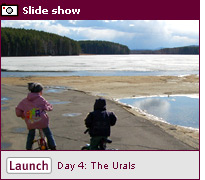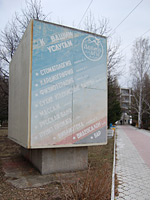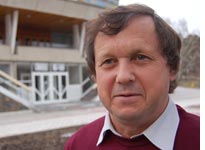A Nuclear Family Vacation in Russia
It took two hours to drive from Chelyabinsk, the regional capital, to Dalnyaya Dacha, winding through a ghostly landscape of birch and pine. Behind the sanatorium gate, the aging residential buildings shed chipped stucco, a smokestack fouled the mountain air, and a fading sign pointed to nonexistent activities such as a sauna and movie room. We received the key for a sparsely furnished room that sported a radio built to receive just one channel, Russian state broadcasting.
There doesn't seem much about the isolated sanatorium that would draw foreigners, but out on the front steps, we found a small crew of middle-aged American men wearing their casual-Friday uniform of pressed slacks and golf shirts.
"I don't think we can work out all the problems in the 30 months we have," said one khaki-clad man. Another nodded in silent agreement, and all three paused to glance at us as we passed. They hardly seemed surprised to run into fellow Americans here.
For all its lack of amenities, Dalnyaya Dacha is ideally located for nuclear tourism (and business). It's roughly equidistant to two of Russia's "secret cities" in the Urals, Snezhinsk and Ozersk. Removed from maps and known only by postal codes, the two cities were quite literally walled off from the outside world.
Snezhinsk (previously Chelyabinsk-70) is home to the All-Russian Scientific Research Institute of Technical Physics, a laboratory that designs and fabricates nuclear weapons, while Ozersk (the old Chelyabinsk-65, or Chelyabinsk-40) houses the Mayak Production Association, an industrial facility that produced plutonium pits (the "triggers" for modern thermonuclear weapons). Both cities are now back on the map but remain off-limits to outsiders. Ordinary Russian citizens, as well as foreigners, need a permit to enter, and the FSB, Russia's security service, has the final say over who may visit.
Closed and protected, the two cities once enjoyed a high standard of living. After the collapse of the Soviet Union, however, nuclear weapons ceased to be a prestige industry, and the once-spoiled cities received a double blow: The institutes couldn't afford to pay and employ all the scientists, yet there was no other economy for the scientists to turn to. The West worried that Russian "weapons of mass destruction scientists," out of greed or sheer self-preservation, would sell their knowledge to rogue states.
That's where Dalnyaya Dacha comes in: The lonely sanatorium has become a way station for foreigners working on the swords-to-plowshares schemes that seek to downsize Russia's massive nuclear weapons complex.
How have these efforts worked?
In some cases, quite well—at least on the surface. Aleksei Shagin, a beneficiary of Western assistance, showed us a brochure for his company, which has received British aid. The photo of blue-eyed, blond-haired girls playing on pint-sized furniture was endearing. Shagin used to work at Mayak, the plutonium production facility; now his private firm, Bur-Invest, manufactures children's furniture.
It was hard to imagine Bur-Invest as a spinoff of a massive complex responsible for building weapons of mass destruction. But he said his old colleagues now envy him. "Of course there was risk, but as the old Russian saying has it, 'He who doesn't gamble will never taste the champagne.' "
Why would someone leave the security of a government job in a Russian research facility for the uncertain prospects of the private sector? Former weapons scientists we spoke with were skilled in terms such as "guerrilla marketing," but in most cases, their businesses were dependent on government customers. Yevgeny Kulbatsky, the general director of Raster-Technology, a packaging company in Snezhinsk that received some startup funds from the U.K. government, said that private industry has an uphill fight, especially in a city where people are often underemployed in make-work jobs, and the payrolls are inflated by "dead souls" (no-show employees).
Kulbatsky recalled how one of his employees discovered—to her chagrin—that she had to come to work on time. "For the same salary at a state enterprise, you can sit at your desk and drink tea eight hours a day, but in our company you have to—excuse my language—get off your ass," he said.
Starting a business in a closed city also carries an extra dimension of risk. The security services can refuse entry to the city without reason or explanation, a risk to both American and Russian investors.
Robert Felton, an American medical doctor turned entrepreneur, made business contacts in Russia through Initiatives for Proliferation Prevention, a U.S. program to help Russian weapons scientists forge partnerships with commercial enterprises. His company, Numotech, won a $10 million loan from the U.S. government's Overseas Private Investment Corp. to launch a conversion project with Spektr-Conversion, a partner company in Snezhinsk. Spektr-Conversion's highly trained engineers and scientists would use their expertise to produce medical equipment, such as affordable prosthetics.
That sounds like a worthy humanitarian task—as well as an excellent business venture. But in the paranoid atmosphere of President Vladimir Putin's Russia, Felton found that working in a closed city can be a real nightmare.
"I've had a lot of problems going to Russia," said Felton, from his office in California. "The FSB put me in a corner and interrogated me for hours, thinking I was a spy. I was almost arrested once. I was detained in Russia—didn't get on a plane because of this project. Strange and bizarre things like that happened."
Felton approached the enterprise with caution; the U.S. Department of Energy invested in a similar initiative in another closed city, Sarov, with little success, he said. Numotech and its Russian partners found a good site, and they spent more than two years (and hundreds of thousands of dollars) lining up all the approvals. Then Putin decided to shake up the regional administration. The old mayor of Snezhinsk landed in jail, and Felton was forced to start from scratch.
"We had all the approvals in order, and now we had to start all over," Felton said.
Anatoly Ivanov, the director-general of Spektr-Conversion and Felton's partner, met with us at Dalnyaya Dacha; we talked on a bench outside the main building as mosquitoes the size of hummingbirds swarmed around our legs. Ivanov seemed upbeat. The partners had received final approvals and the venture was going forward.
"We think we can set a good example—if you start a joint venture, it'll show them how you can do it," Ivanov said. "And step by step, the closed cities will open."
The Spektr-Conversion project, however, has met official indifference—and little economic assistance—from Russian officials, Ivanov said.
"From the Russian side, you look at it and think, golly gee, the Americans are more interested in seeing this succeed than the Russians!" he said. "But, of course, the Americans' motives are different. They don't want Russian nuclear weapons scientists to go off to work in Iran or Iraq or wherever."
Are these programs worth all the hassle? As Elizabeth Turpen, a former congressional staffer put it, for less money than the United States has spent on cooperative threat reduction, we could simply pay all the underemployed Russian weapons scientists to retire. That raises the question: Why keep up the charade? The simple answer, she said, is that U.S. taxpayers would never tolerate the notion of charity.
Yet there's been little thought given to long-term sustainability—projects often try to find technologies and then the market, rather than vice-versa. It is knowledge, as much as nuclear materials, that pose a proliferation threat, said Turpen, who now works on these issues at the Stimson Center.
"People problems are inherently more difficult," said Turpen, noting that Russian weapons scientists, much like their U.S. counterparts, would like to keep their arsenal safe and secure. But when it comes to feeding their families, they may have few choices, and that's ultimately why the cooperative programs, for better or worse, are important.
"I don't think Russian scientists are out to create doomsday," Turpen said. "That is, unless they're destitute."


